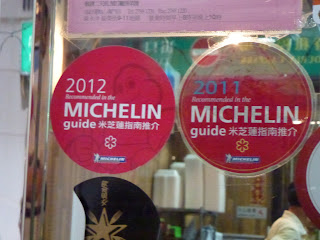Remember these stickers?
There's another, much more famous dim sum place that has received a Michelin Star.Tim Ho Wan (添好運) who brand themselves as "The Dim Sum Specialists", has a local reputation for being the cheapest One-star restaurant around. While that may not be true anymore (over the last couple of years the prices have risen dramatically, and One Dim Sum yesterday was cheaper), and despite various anecdotes of the quality dropping since they received the star a few years ago, I decided to try it anyway.
I arrived with my family at the restaurant, on the outskirts of Mong Kok, at 11:30. We went and got a number-cum-order form, and the maitre d' (if you can call some random guy who is occasionally at the front door that) told us that it would be at least a couple of hours before we could get in. We had expected this, and decided to go around Mong Kok (again!) for a while.
 |
| Just another fruit market on the street. |
Until 2:20, when we went in. So about a three hour wait. Apparently, that's completely normal for this place.
Part of Tim Ho Wan's claim to fame is that the dim sum is always steamed fresh to order. That, coupled with the insanely small shop, means that the restaurant can only accommodate a very limited number of people over the course of a day. Indeed, midway through our wait, at about 1:45, a sign was posted telling people who had just came to leave and come back after 3:30 to get a number.
So this had better be some fine dim sum!
The first thing that arrived was har cheung (蝦腸):
Really, nothing special here. Although the rice noodle roll was just a bit more aromatic than usual.
The house specialty was the flaky crust char siu bao (酥皮叉燒包), kind of like a cross between a pineapple bun and a char siu bao (roast pork bun).
Very interesting and novel.
They had shrimp spring rolls (鮮蝦春捲), which you're supposed to dip in worchestershire sauce (don't ask why, they really like worchestershire sauce here!)
Crispy, not oily, and the filling was quite delicious. It was shrimp with some cabbage and pickled cabbage (酸菜, lit. sour vegetable), and the flavours matched each other very well.
Some dim sum standards:
 |
| har gow (蝦餃) |
 |
| siu mai (燒賣) |
Phoenix talon and sparerib rice (for my brother):
There's no way to do this one wrong!
Turnip cake:
Again, the natural flavours of the daikon radish and Chinese sausage came through better than usual, with there being a slight sweet tinge to the daikon - other places usually make up for the slight natural sweetness by putting in sugar and MSG, but it tastes completely different.Beef meatballs (牛肉球):
Chinese meatballs are made by pulverizing the meat instead of grinding it, giving it a completely different texture from western meatballs. In addition, the large kind served as dim sum is mixed with fillers and tenderizing agents to give it an almost mushy quality. And then it's dipped in worchestershire sauce.
Tim Ho Wan advertises its use of chenpi (陳皮), dried tangerine skins, in its meatballs, but I didn't taste any.
The unexpected star of the meal was this lo mai gai:
Everything about it was just perfect. Every single bite gave you some sticky rice that wasn't mushy and had the aroma of the lotus leaf surrounding it and the taste of the chicken and Chinese sausage inside. In the middle were large slices of chicken (most places use minced mystery meat), whole shittake mushrooms, and chunks of Chinese sausage. I have honestly never had lo mai gai this good before.
Dessert was another specialty of the place, wolfberry osmanthus jelly (杞子桂花糕):
The wolfberry is a fruit which has in recent years been hailed (as "goji") as a great restorative agent by the homeopathic movement and commercial interests which have capitalized on that. Meh. The osmanthus is a fragrant flower native to Asia. Put them together in a jelly, and you get a sublime dessert. Not overly sweet, wonderfully fragrant, and it feels like nothing going down.
Overall, it was a great meal, and at a great price, but the crowds make it just not worth it. Three hours. On a rainy Thursday. Wow.
Overall, it was a great meal, and at a great price, but the crowds make it just not worth it. Three hours. On a rainy Thursday. Wow.











No comments:
Post a Comment